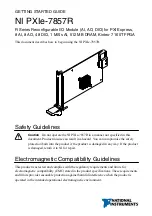
©
National Instruments Corporation
2-1
2
Using the SCXI-1126
This chapter describes the input and output signal connections, and
includes specifications and connection instructions to the SCXI-1126
module using the SCXI-1126 front connector and rear signal connector.
Signal Connections
If you are using a terminal block with the SCXI-1126, refer to the terminal
block installation guide documentation for signal connection information.
This section provides information about various signal types such as
floating, ground-referenced, signals with or without high common-mode
voltage, and signals with or without unwanted DC components, and how to
connect them.
Analog Input Channels
Each input channel pair corresponds to a separate frequency input channel
and is fully isolated from the other inputs and from earth ground. The inputs
are designed in a floating single-ended configuration, which allows the
measured signal to be referenced to a ground level with common-mode
voltage up to 250 V
rms
. Figure 2-1 shows how to connect a
ground-referenced signal to the SCXI-1126. Figure 2-2 shows how to
connect a floating signal, and Figures 2-3 and 2-4 show how to AC couple
signals to remove unwanted DC components on the SCXI-1126.
Figures 2-1 through 2-4 show the signal path from the signal source up to
the E Series DAQ device. The signal exits the SCXI-1126 and enters the
E Series DAQ device, which is configured in differential (DIFF) mode.
Notes
For better noise immunity or to reference floating signal sources, connect the
negative input channel to the chassis ground as shown in the
Optional
boxes of Figure 2-2
and Figure 2-3. If the application requires isolation, do not connect to chassis ground.
If you are using the SCXI-1304 or SCXI-1305 terminal block, leave the switches in
G
, the
ground-referenced position, when the application requires isolation. Placing the switch
in
F
, the floating position, engages the bias resistor that connects the negative signal (CH–)
of each channel together. This breaks the channel-to-channel isolation barrier.
















































